Using Our Water Resources Efficiently
Responsible use of water is a fundamental component of sustainability at Mosaic. Our water management programs include companywide targets and facility-level initiatives to reduce our water footprint.
The work of mining and processing potash and phosphate minerals is energy- and water-intensive. At Mosaic, we strive to maximize efficiencies and minimize our use of natural resources, and have made significant progress in reducing the company’s environmental footprint.
Continuous improvement is integral to our business. Through innovative processes, significant investments, strategic engagement and partnerships, and an ongoing focus on efficiency and conservation, we are working to minimize our impact each year while providing farmers with vital crop nutrients that help grow food.
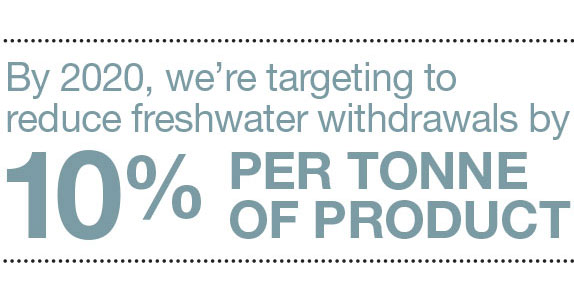
Our Commitment to Water

We take an “every drop counts” approach to water management, and we aim to recycle or reuse water at every opportunity. We set measurable goals and hold ourselves accountable for the reduction of water use.
The primary sources of water for our Florida, New Mexico and Saskatchewan operations are surface water, rainwater and groundwater. Secondary sources of water include water supplied by local authorities and partially treated industrial and domestic reclaimed water, also supplied by local authorities. Reclaimed water is former wastewater that is treated to remove solids and impurities, and recycled. Surface water withdrawals include once-through cooling water used by facilities in Louisiana. We are also collaborating with local governments and industries to use alternative water sources to reduce impacts on local water supplies.
“At Mosaic, we believe the long-term success of our business depends on the health of our operating communities—and the natural resources on which we all rely. Water is a precious resource that requires great care at our facilities and elsewhere,” said Jim Prokopanko, President and Chief Executive Officer of The Mosaic Company. “We use water responsibly, and we’ve set a target to achieve even greater improvement on companywide freshwater water use.”
Announced in this year’s report are our new Sustainability Targets. The intent of our water target is to drive water efficiency improvements across our business and to increase the use of alternative water sources.
Facts on Our Water Footprint
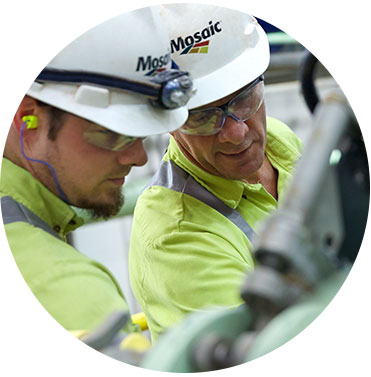
- Mosaic withdraws approximately 300 million m3 of water annually across our operations
- Mosaic’s average freshwater use per tonne of product was 4.59 m3 in 2014
- Mosaic reused or recycled approximately 90% of water used at Florida phosphate and Saskatchewan potash operations in 2014
- Mosaic partnered with 11 different government organizations and companies to use more than 3.5 million m3 of water from alternative sources in 2014
- Mosaic has reduced withdrawals of groundwater, one of the most sensitive water resources, by 15% since 2005 in phosphates operations
Our Water Reduction Actions:
Continue
commitment to water stewardship companywide
Establish
site-specific goals to drive water conservation at the facility level
Increase
use of reclaimed water*
Evaluate
additional partnerships with industry and government to use alternative water sources
Reducing Water Use in Our Phosphate Production
How Water is Used in Phosphate Production
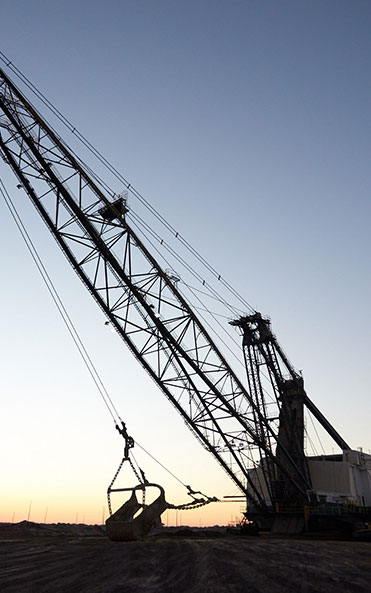
Phosphate rock is typically found 15-50 feet beneath the ground in a mixture of phosphate pebbles, sand and clay known as phosphate “matrix.” The sandy layer above the matrix, called the overburden, is removed using electrically operated draglines. Equipped with large buckets, these draglines remove the overburden, placing it in the previously mined voids, and excavate the matrix, depositing it into a shallow containment area. There, high-pressure water guns turn the material into a watery mixture called slurry, which is sent through pipelines to a processing facility, referred to as a beneficiation plant, where phosphate rock is physically separated from the sand and clay in the matrix.
At the plant, the slurry is moved through a series of washing stations and vibrating screens that physically separate clay, sand and pebble-sized particles. The separated phosphate pebbles are moved through dewatering tanks and onto an inventory pile via conveyor belt. The clay particles are then pumped through pipelines into storage ponds (clay settling areas) where these particles sink to the bottom.
The smallest particles of sand and phosphate are further separated at a flotation plant. The sand is returned by pipeline to the mine area for use in land reclamation, while the phosphate concentrate is sent to dewatering tanks and then to the inventory pile. The phosphate minerals are then transported to a separate fertilizer manufacturing plant to make our finished products.
Continuous Water Improvement at Our Florida Facilities
Water management during the mining and production processes is an extremely important part of our operations. We are continually updating our long-term water strategy for our Florida operations, with the goal of conserving water resources and reducing the amount of water we impound for operational use. Today, Mosaic’s Central Florida facilities operate on more than 90% reused or recycled water. Recycled water is used at both our mines and fertilizer plants to reduce groundwater withdrawals.
Our Plant City facility uses approximately 2 million gallons per day of reclaimed water, which is former wastewater that is treated to remove solids and impurities, from local utilities. This process cuts the facility’s groundwater extractions in half compared to historical levels.

Our Bartow facility has been engaged in continuous improvement strategies to reduce water use since 2011. Each year the plant takes part in initiatives to reduce freshwater use, reuse process water, and reduce process water inventory through the use of reverse osmosis (RO) and evaporation. Employees played an important role in suggesting and implementing water savings at the facility, including installing pump seals, eliminating freshwater usage from the ball mill system, stopping condensation/steam leaks, extending demineralization regeneration cycles, installing low-flow toilets, and keeping water levels in balance, particularly during heavy rain and hurricane seasons. The changes improved operational and environmental sustainability. One initiative, a change to the RO treatment plant, recycled an additional 300 gallons of water per minute for use at the facility—further reducing the facility’s reliance on groundwater sources.
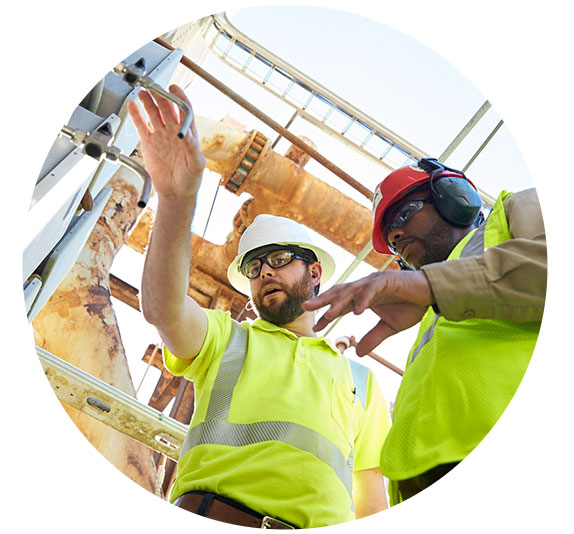
Reducing Water Use in Our Potash Production
How Water is Used in Solution Potash Mining
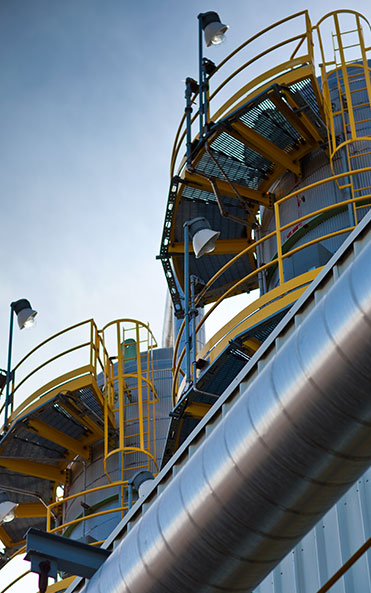
Saskatchewan potash is extracted from deep underground deposits using either conventional (mining machines) or solution mining techniques (brine is used to remove the mineral solutions). To mine at depths greater than 1,000 meters (1 km), it is safer to solution mine.
Mosaic operates the world’s largest potash solution mine in Belle Plaine, Saskatchewan. About 2.2 million tonnes of potash finished product are produced at Belle Plaine each year.
Potash solution mining is a resource-intensive process. During solution mining, warm water is pumped down wells into the potash formation. Potassium and sodium salts are dissolved deep underground and the resulting solution is pumped to the plant on the surface, where the potash is removed. Large amounts of water are removed from the solution using evaporators. The evaporated water is recovered and reused. The solution is heated, and water is evaporated in order to concentrate the potash in the solution and crystallize out salt (NaCL). The potash rich solution is then cooled through the crystallization process where the potash mineral sylvite (KCL) is produced.
Another method of recovering the potash is through the use of cooling ponds. The cooling pond technology developed at Belle Plaine was a breakthrough innovation for the site that reduces the energy required to manufacture potash products. The warm salt (NaCL and KCL) rich solution flows into outdoor ponds. As the solution cools, potash crystallizes and precipitates to the bottom of the pond floor. Dredges are used to collect the crystals and pump them in a slurry to the plant, where it is separated out.

Saving Water Through an Innovative Agreement in Saskatchewan
Through an agreement with a third-party industrial partner in Saskatchewan, Mosaic’s Belle Plaine facility is able to use alternative source water. This process avoided the use of more than 200,000 m3 of freshwater use in 2014. The Belle Plaine facility sends water to be used in a cooling process at a nearby plant. The heated water returns to Mosaic’s facility to be used as part of the potash production process. This synergy allows Mosaic to reduce the amount of energy that would have otherwise been used heating the water, while allowing the industrial partner to avoid cooling costs.

Mosaic Belle Plaine Water Agreement:
Avoids
approximately 200,000 m3 of freshwater use through wastewater use each year
Saves
more than $1 million in energy savings each year
Generated
more than half a million gigajoules in energy savings in 2014
Avoided
approximately 30,000 metric tonnes CO2e emissions in 2014
Innovation Helps Us Keep Improving

Mining, producing and delivering millions of tonnes of crop nutrients each year to customers around the globe is complex. It requires teams of dedicated professionals working to make responsible decisions each day and at every step in the production and supply chains. At Mosaic, we are continually developing innovative ways of doing our critical work. These innovations increase our efficiency while demonstrating our respect for the Earth’s resources.
*Reclaimed water is former wastewater that is treated to remove solids and impurities, and recycled. Reclaimed water accounts for 2% of Mosaic’s Florida water withdrawals, including groundwater, municipal water and wastewater.
